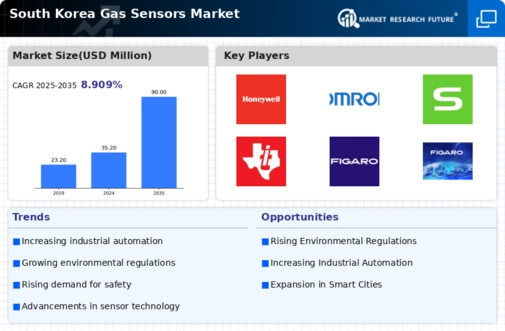Growing Environmental Concerns
Environmental awareness is becoming a pivotal driver for the gas sensors market in South Korea. With rising concerns about air quality and pollution, there is a heightened demand for gas monitoring solutions across various sectors. The government has implemented stricter regulations regarding emissions, prompting industries to invest in gas detection systems to comply with these standards. In 2025, the market is expected to reach $200 million, with a growth rate of approximately 15%. This trend indicates a shift towards sustainable practices, as companies seek to minimize their environmental impact. Consequently, the gas sensors market is likely to benefit from this growing focus on environmental protection and compliance.
Rising Industrial Safety Standards
The gas sensors market in South Korea is experiencing growth due to the increasing emphasis on industrial safety standards. Regulatory bodies are mandating the use of gas detection systems in various sectors, including manufacturing and construction. This trend is driven by the need to prevent accidents and ensure worker safety. In 2025, it is estimated that the market for gas sensors in industrial applications will reach approximately $150 million, reflecting a growth rate of around 10% annually. Companies are investing in advanced gas detection technologies to comply with these regulations, thereby propelling the gas sensors market forward. As industries adopt more stringent safety measures, the demand for reliable and efficient gas sensors is likely to rise, further solidifying their role in maintaining safe working environments.
Expansion of Smart City Initiatives
The push for smart city initiatives in South Korea is driving the gas sensors market. As urban areas evolve, there is a growing need for integrated monitoring systems that can detect and manage air quality. Gas sensors play a crucial role in these systems, providing real-time data to city planners and environmental agencies. The market is projected to grow by 10% annually as municipalities invest in smart technologies to enhance urban living conditions. This trend reflects a broader commitment to sustainability and public health, as cities aim to reduce pollution levels. The gas sensors market is likely to thrive as smart city projects gain momentum, creating new opportunities for innovation and development.
Technological Advancements in Sensor Design
Innovations in sensor design are significantly impacting the gas sensors market in South Korea. The development of miniaturized sensors with enhanced sensitivity and selectivity is enabling more accurate detection of hazardous gases. These advancements are crucial for applications in sectors such as oil and gas, where precise monitoring is essential. The market is projected to grow by 12% annually, driven by the introduction of smart sensors that integrate with IoT platforms. This integration allows for real-time monitoring and data analysis, enhancing operational efficiency. As industries increasingly adopt these advanced technologies, the gas sensors market is likely to expand, catering to the growing demand for sophisticated detection solutions.
Increased Investment in Research and Development
Investment in research and development is a key driver for the gas sensors market in South Korea. Companies are focusing on developing next-generation gas sensors that offer improved performance and reliability. This trend is supported by government initiatives aimed at fostering innovation in the technology sector. In 2025, R&D spending in the gas sensors market is expected to increase by 20%, reflecting a commitment to advancing sensor technologies. This investment is likely to lead to breakthroughs in detection capabilities, enabling the market to address emerging challenges in gas monitoring. As a result, the gas sensors market is poised for growth, driven by continuous innovation and technological advancements.


















Leave a Comment